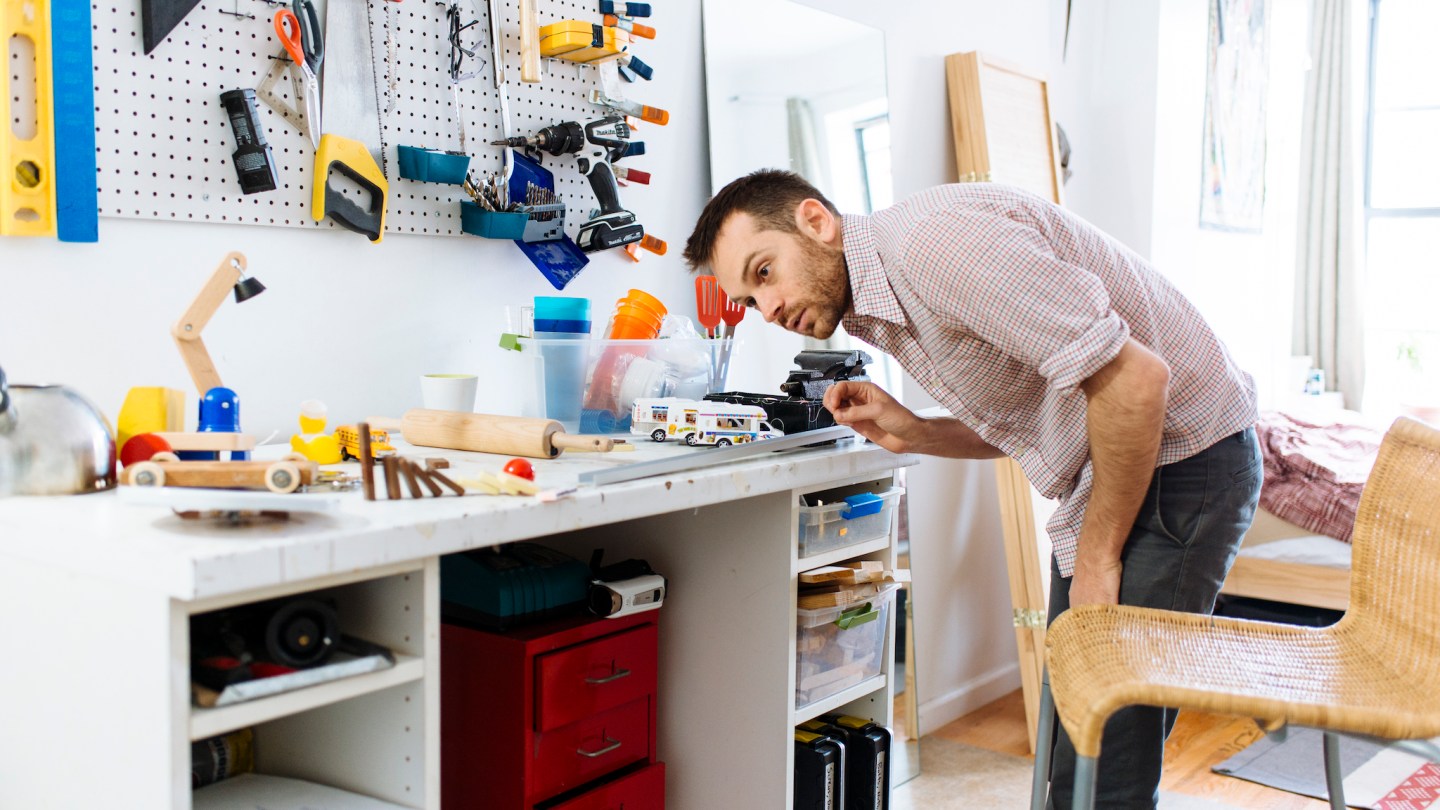When he was growing up in Auckland, New Zealand, Joseph Herscher’s parents didn’t mind when he made a mess. Each time he worked on craft projects in the living room of their house, they encouraged him to let his imagination run wild.
“The wackier it was, the more my parents supported it,” Herscher says, “which provided a really great environment to be creative.”
He remembers that they had piled materials for his flights of fancy into what they called a “make-it” box.
“It was a box of random junk that they wouldn’t throw out, like toilet paper rolls and random pieces of furniture,” Herscher says. “When I was bored, I would get down the make-it box and see what I could build. I’m not the best tradesman, but I’ve taught myself to figure it out along the way.”
Herscher’s make-it box has evolved into many containers piled high with objects just waiting for their big moment on stage. At some point, they’ll become part of one of his Rube Goldberg machines. These are elaborate, eccentric contraptions that are created to complete simple tasks, like pouring a glass of water or stamping an envelope. The concept was popularized in the late 1800s by cartoonist Rube Goldberg, who drew schematics of these machines, but never actually built one himself.
The result? Sort of like a grown-up version of the children’s game Mouse Trap. Except that instead of taking up part of the kitchen table, Herscher’s contraptions can expand to fill much of his apartment in Williamsburg, Brooklyn.
And the point? Not having a point is the whole idea, says Herscher.

“One of the biggest things is allowing myself to play with the objects involved with no direction in mind except to observe how things interact with each other,” Herscher says. “That’s fun for me, discovering things that make me smile.”
And he’s managed to entertain more people than he ever dreamed possible. The video of his first large-scale Rube Goldberg machine—a dizzying work called “Creme that Egg”—went viral, receiving nearly 3 million views on YouTube. His device was impossibly elaborate, complete with a teakettle, several hammers, and a tiny stage full of animated figures.
He didn’t start off as a kinetic artist. He was working as a software engineer before deciding to quit his day job to focus on his art in 2012. He’s created dozens of machines, but many of them, like the one at the center of Creme That Egg, had to be dismantled. (That one at the insistence of an angry landlord who didn’t appreciate 500 thumbtack holes in the walls.)
His latest work is a comedic web series entitled “Jiwi’s Machines.” The project includes a quartet of 10-minute episodes that took two years to complete. Herscher appears in each as a sort of mad scientist creating devices to do things like pour his morning glass of orange juice. Not to give away too much, things don’t always go as planned for the creator or his assistant.
His approach to making the machines begins with the ending in mind, which usually consists of an “inanely stupid task” such as switching on a light or buttering a piece of toast. The rest is trial and error as Herscher attempts to experiment with the unruly laws of physics. With a few sparks of inspiration in mind, he sources materials from junk shops around Brooklyn, finally returning to his Williamsburg studio to experiment with his new toys. The whole process can take anywhere from a month to a year, depending on the complexity of the project.

A social media sensation, Herscher realized there was a market for his creations. And he wasn’t the only one. Advertisers began contacting Herscher to create machines that would serve a cocktail or untwist a packaged loaf of bread. He’s landed various public speaking jobs at schools where thinking outside the box is highly valued. After all, Herscher’s philosophy for innovation can be applied to nearly any field. It’s all about encouraging a forward-thinking mentality by considering how unexpected materials can be used in unexpected ways.
“We are fascinated with the physical world,” Herscher says. “Kids, especially, will stare at the simplest thing because it is magical to them. Like the way something might roll, or the way something might move, or a balloon floating up into the air. Kids are building their mental model of the world at that time. There is so much potential for magic in everyday objects around us if we tap into our inner child.”
He says that looking at everyday objects in an almost childlike manner can inspire a whole different kind of creative thought process.
“I love walking down the streets of New York City and seeing construction workers,” he says. “I’m so fascinated by the crane’s movement, I’ll stop and watch it for ages.
Herscher says he finds Williamsburg especially inspiring.
“To me, it’s like a playground where I can find anything I need,” he says. “I’ve spent countless hours tinkering in the junk stores playing with cups on the floor, and no one bats an eyelid. You can be a weirdo here.”
Photo credit: Lauren Kallen




